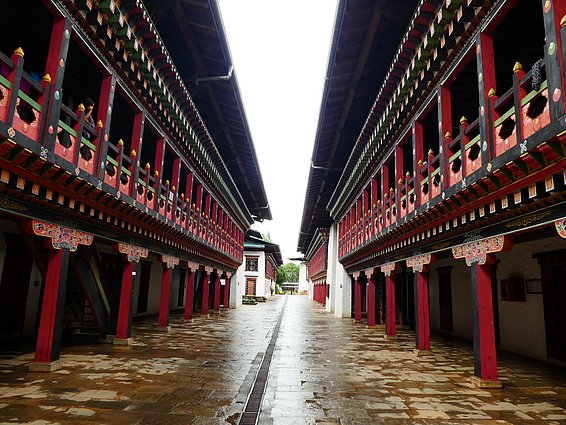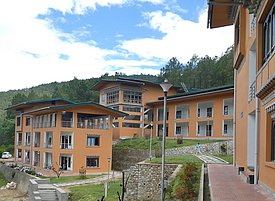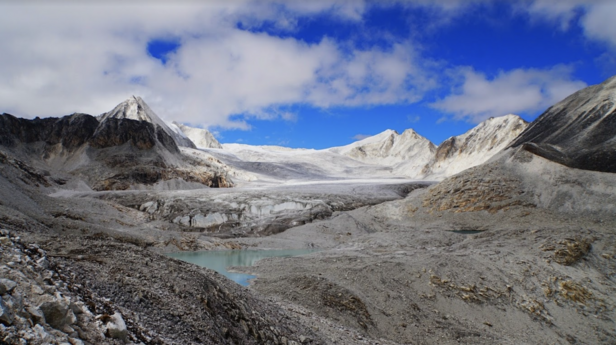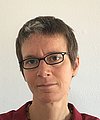The SLF is researching permafrost and snow in Bhutan at an altitude of over 5000 meters and, together with the local population, is developing measures to reduce climate-related risks in the mountains. The Swiss National Science Foundation is funding the Cryo-Spirit project.
This text was automatically translated.
Almost two years of intensive preparation were required. Now the time has come: Nadine Salzmann, head of the Alpine Environment and Natural Hazards research unit at the SLF, will set off for Bhutan next Saturday, September 14. In the small kingdom in the Himalayas, she will conduct numerous experiments and collect data on the cryosphere (see box), in particular on permafrost and snow. "We are using methods that we previously tested in Switzerland and are now ready for the extreme conditions there," says Salzmann.
Her team is also pursuing a gender-specific approach to risk analysis. Among other things, this involves looking at how local women, who often work in agriculture, deal with hazards such as landslides, changes in water supply or glacial lake outbursts - and whether their perspective and knowledge of the local situation can improve early warning systems. "There are not many studies on this, we want to advance the topic," explains Salzmann.
What is ... the cryosphere?
The cryosphere of a planet or moon comprises its occurrence of water in solid form, i.e. ice and snow. This includes glaciers, sea ice and snow cover, but also snow and ice crystals in clouds. The cryosphere plays a crucial role in the climate system and influences the weather, sea level and global temperature.
Her work is part of the Cryo-Spirit project funded by the Swiss National Science Foundation. Bhutan and Switzerland are facing similar challenges in times of climate change. The collaboration makes it possible to further develop the sensors from Switzerland and thus increase the amount of data for one of the world's most remote high mountain regions. On this basis, strategies are to be developed on how people in mountain regions can adapt to the rapidly advancing climate change. Another important goal is to improve education and research locally and to promote young women in science in particular.
But it will be a while before Salzmann can get started. It takes her three days just to travel from Davos to Lobesa. This is where the College of Natural Resources, the Faculty of Natural Resources at the Royal University of Bhutan, is located. "Before the fieldwork, we will hold a few seminars here for Master's students on permafrost, snow, glaciers in the high Alps and how climate change and climate extremes are changing the risks in the high mountains and lower-lying regions," she says, describing the program in Lobesa.
She and her team, two researchers from the Swiss cooperation partner University of Fribourg, a colleague from MeteoSwiss and two doctoral students from Bhutan itself, then have six days of walking ahead of them. This is unusual, as the proportion of women at the Royal University, especially in doctoral positions, is low.
Search for risks ¶
On 24 September, after a journey of around 80 kilometers and more than 3,000 meters in altitude, the group will reach their research site on the Thana Glacier at 5,000 meters above sea level. They will measure various data on the way there, including installing around 30 sensors to measure the temperature of the permafrost at intervals of one hundred meters. "We will also instruct the local scientists on the way so that they can collect data and install and maintain the measuring devices independently in future," explains Salzmann.
The researchers are also mapping landforms that indicate permafrost, such as rock glaciers. These include debris slopes, glacier forefields and ice-filled moraines. The team focuses on locations that indicate potential risks from thawing permafrost. For example, lakes behind moraine walls can suddenly erupt and flood the land below. "Our aim is to create the first regional map of potential permafrost occurrence in Bhutan," says Salzmann.
Dialog with the population, politicians and the royal family ¶
Among other things, the team will install a measuring instrument on the Thana Glacier itself in order to determine the snow water equivalent (SWE, see box) continuously and on a daily basis. It will also replace and supplement several existing instruments on site. "This will make Bhutan's most important research area fit for cryosphere measurements," says Salzmann happily.
She then makes her way back through the world's only climate-neutral country. Nature conservation and the happiness of the population are important political goals here, gross national happiness is more important than economic growth and gross national income.
Before Salzmann returns to Switzerland on 12 October, she wants to raise awareness of the risks in the region among the local population, politicians and royalty - and discuss with them how they can deal with them. "Our aim is to get the government on board with this project at an early stage," says the researcher.
What is ... the snow water equivalent (SWE) and how is it measured?
A snowpack consists of numerous layers of more or less compressed (dense) snow. The snow water equivalent indicates how high a layer of water would be after the snow cover has melted, expressed in millimeters. Each millimetre corresponds to one liter of water per square meter of snow cover. One centimetre of fresh snow with a typical density of one hundred kilograms per cubic meter results in one millimetre of water. An example: in mid-April 2024, the average density of the snow cover on the Weissfluhjoch test field was 416 kilograms per cubic meter, which corresponds to a water value of around 1100 millimeters or 1100 liters of water per square meter at a snow depth of 2.7 meters.
The snow water equivalent is traditionally measured by weighing a column of snow with a known volume. The measuring instrument used in Bhutan is based on the cosmic ray method. Neutrons from naturally occurring cosmic radiation are detected under the snow cover. Their intensity depends on the amount of snow. This allows the snow water equivalent to be measured continuously.
Copyright ¶
WSL and SLF provide image and sound material free of charge for use in the context of press contributions in connection with this media release. The transfer of this material to image, sound and/or video databases and the sale of the material by third parties are not permitted.



